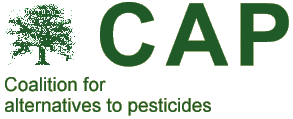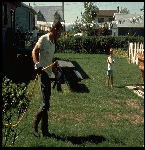|
|

|
 The Effects of Pesticides on Health The Effects of Pesticides on Health
- Fetuses and young children (whose immune systems are immature) are especially vulnerable to the toxic effects of pesticides. Specifically, children tend to suffer from increased rates of behavioral and learning problems, and cancer 6,7,8. People with impaired immune systems are also especially at risk 8.
- Many pesticides are excreted in mother's milk and can affect nursing babies 2,3. (This is not to imply that cow's milk is necessarily any safer for infants, however!)
- Farm animals and pets are also at risk. One recent study showed a significant association between a cancer in dogs (canine malignant lymphoma) and owner's use of 2,4-D herbicides. The histology and epidemiology of this disease is similar to non-Hodgkins's lymphoma in humans 4.
- Clearly, not all pesticides are associated with all these effects. (For example, herbicides cause some effects; insecticides, others.) For detailed
data, contact CAP at (450) 441-3899.
Back to top
 References References
- American Defender Network (1989) Questions and answers about lawn chemical dangers. Illinois.
- Canadian Center for Occupational Health and Safety (1990) Personal communication with Ms. H. Nadeau and reprints from various published sources supplied by the Center. (Contact CAP for details.)
- Environment Canada (1989) Pesticides: the right amount.. Ottawa.
- Hayes, HM et al (1991) Case-control study of canine malignant lymphoma: positive association with dog owners use of 2,4-Dichlorophenoxyacetic acid herbicides. Journal of the National Cancer Institute. 83:1226-31
- Hayes, WJ & Laws,ER (eds) (1991) Handbook of pesticide toxicology . San Diego: Academic Press
- Dr. June Irwin, MD. Various published sources. (Contact CAP for details.)
- Lowengart, R. et al (1989) Childhood leukemia and parents' occupational and home exposure to pesticides. Journal of the National Cancer Institute, 79:39-46.
- Urban Pesticide caucus (1991) Regulating urban cosmetic use of synthetic pesticides: action plan for Ontario. Toronto.
- United States General Accounting Office (1986, 1990) Reports on pesticides and their risks. Washington.
- United Stated Navy (1982) Emergency medical treatment for acute pesticide poisoning. Jacksonville, Florida.
- Wigle, DT et al (1990) Mortality study of Canadian male farm operators: non-Hodgkin's lymphoma mortality and agricultural practices in Saskatchewan. J. Nat. Cancer institute, 82:575-582 and see Zalm, SH et al (1990) Case -control study of non-Hodgkin's lymphoma and the herbicide 2,4-D in Eastern Nebraska. Epidemiology, 1:349-356.
�
Back to top
|
|
|
|
|
© 2000 Coalition for Alternatives to Pesticides
Webmaster: Shawn Buzzell
|
|



